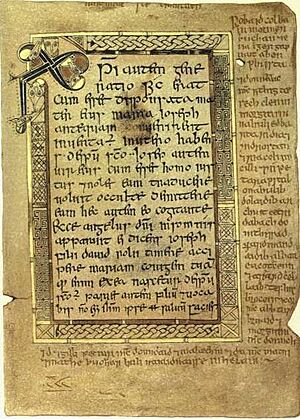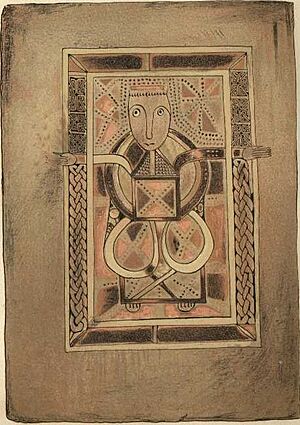Book of Deer facts for kids
The Book of Deer is a very old and special book from Scotland. It's a Gospel Book, which means it contains parts of the Christian Gospels. It was made around 1,000 years ago, in the 10th century! What makes it extra special are the notes added later, in the 12th century. These notes are written in Scottish Gaelic, and they are the oldest surviving Gaelic writings from Scotland.
The book gets its name from a place called Old Deer in Aberdeenshire, Scotland. It's thought to be the oldest surviving book made in Scotland. The Book of Deer is a type of "pocket gospel book." These were small books made for people to use privately, not for big church services.
The book has 86 pages, called folios. Each page is about 15.7 cm by 10.8 cm. It's written on vellum, which is a type of treated animal skin, using brown ink. Today, it has a modern cover. The Book of Deer has been kept at the Cambridge University Library in England since 1715. It was given to the University of Cambridge by King George I.
Contents
What's Inside the Book of Deer?
The main part of the Book of Deer is written in Latin. It has the complete Gospel of John, and parts of the Gospels of Matthew, Mark, and Luke. It also includes a small part of a prayer service for sick people and the Apostles' Creed, which is a statement of Christian beliefs. The book ends with a short note in Old Irish.
The Gospel texts are based on the Vulgate, a Latin version of the Bible. They were written by one person, called a scribe, using a small, flowing style of writing. Even though the writing style is similar to Irish books, many experts believe this book was made in Scotland.

Gaelic Notes in the Margins
One of the most exciting parts of the Book of Deer are the seven notes written in Scottish Gaelic! These notes are found in the empty spaces around the main Latin text. They are called marginalia. These Gaelic notes are the oldest surviving examples of Gaelic writing from Scotland.
The notes tell us important things about the past. They include a story about how the monastery (a religious community) at Deer was started by St Columba and St Drostan. They also record five times when land was given to the monastery. Another note says the monastery didn't have to pay certain taxes. There's also a copy of a Latin document from David I of Scotland, a king, that protected the monastery from unfair demands. Different people wrote these Gaelic notes. They help us understand how the Gaelic language developed in Scotland.
The Book of Deer also has a few small mistakes. For example, in the family tree of Jesus in the Gospel of Luke, it accidentally lists Seth as the first man and grandfather of Adam.
Beautiful Pictures and Decorations
The Book of Deer is an illuminated manuscript. This means it has beautiful pictures and decorations. It has a well-planned set of illustrations.
There are four full-page pictures of the Evangelists, who wrote the Gospels. Each picture faces a page of text that has a decorative border made of interlace patterns (like woven ribbons). Each of these text pages also starts with a large, decorated letter. The book begins with a full-page picture showing all four Evangelists together. It also ends with two more full-page pictures of the Evangelists. The very last part of the Gospel of John finishes with a smaller picture of two men.
Throughout the book, there are also many small, decorated letters. In the second half of the book, ten pages have small drawings in the margins. These drawings show people, animals, or simple doodles.
Where Did the Book Come From?
The book gets its name from the monastery of Deer. This monastery is mentioned in the Gaelic notes and in the Latin document from King David I. Sadly, we don't have many other records of this original monastery. However, a different monastery, founded nearby in 1219, did own some of the lands mentioned in the Gaelic texts.
As mentioned, the Book of Deer arrived at Cambridge University Library in 1715. This happened when King George I bought the collection of John Moore, who was a Bishop, and gave it to the University. Before this, the book was probably owned by Thomas Gale, a headmaster in London. We don't know exactly how Bishop Moore got the book. Some people think it might have been taken during the Wars of Scottish Independence in the late 1200s or early 1300s.
Images for kids
-
Folio 5r shows text from the Gospel of Matthew. Notice the special Chi Rho symbol in the top left corner. The edges of the page have notes written in Gaelic.




